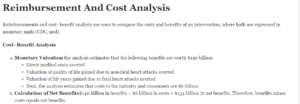Reimbursement And Cost Analysis

Reimbursements and cost–benefit analysis are ways to compare the costs and benefits of an intervention, where both are expressed in monetary units (CDC, nod).
Cost–Benefit Analysis
- Monetary Valuation the analysis estimates that the following benefits are worth $140 billion:
- Direct medical costs averted
- Valuation of quality of life gained due to non-fatal heart attacks averted
- Valuation of life years gained due to fatal heart attacks averted
- Next, the analysis estimates that costs to the industry and consumers are $6 billion.
- Calculation of Net Benefits$140 billion in benefits – $6 billion in costs = $134 billion in net benefits. Therefore, benefits minus costs equals net benefits.
Net benefit = Benefits – costs
= $140 – $6
= $134 billion
Part A. Monetary Valuation
The analysis estimates that the following benefits are worth $200 billion:
- Direct medical costs averted
- Valuation of quality of life gained due to non-fatal heart attacks averted
- Valuation of life years gained due to fatal heart attacks averted
Next, the analysis estimates that cost to the industry and consumers is $17 billion.
- Calculate the net benefits.
- What does the value tell you as an administrator relative to the benefit of the procedure?
Part B. Reimbursement Methods
Answer the following questions:
- What are the various reimbursement methods used by third-party payers?
- What incentives are given to providers under each of these reimbursement protocols?
- How do these reimbursement methods impact the delivery of health services?
- What is capitation?
- What are the advantages and disadvantages of each of these reimbursement methods?
In summary, solve the problem in Part A, and write a 5-page analysis in response to the questions in Part B. Cite at least 5 references in APA format.
Submitting your assignment in APA format means, at a minimum, you will need the following:
- Title page: Remember the running head. The title should be in all capitals.
- Length: 5 pages minimum
- Body: This begins on the page following the title page and must be double-spaced (be careful not to triple- or quadruple-space between paragraphs). The typeface should be 12-pt. Times Roman or 12-pt. Courier in regular black type. Do not use color, bold type, or italics, except as required for APA-level headings and references. The deliverable length of the body of your paper for this assignment is 5 pages. In-body academic citations to support your decisions and analysis are required. A variety of academic sources is encouraged.
- Reference page: References that align with your in-body academic sources are listed on the final page of your paper. The references must be in APA format using appropriate spacing, hanging indent, italics, and uppercase and lowercase usage as appropriate for the type of resource used. Remember, the Reference page is not a bibliography but a further listing of the abbreviated in-body citations used in the paper. Every referenced item must have a corresponding in-body citation.